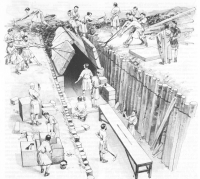
7. Economy
Who paid for the construction of an aqueduct?Here a set of questions with relevant answers, some of which are linked to related subjects as discussed in other places within this website www.romanaqueducts.info
Additional questions or remarks are most welcome via w.d.schram 'at' romanaqueducts.info
Questions
- Was aqueduct water free of charge?
- What does an aquduct cost?
- Who paid for the construction of an aqueduct?
Leveau (1991) estimated that it cost between one and three million sesterces per kilometre on average to build an aqueduct.
Answer
The construction of an aqueduct often took many years and was expensive. Nevertheless the water as delivered to public fountains was free of charge. Only those favored by the Emperor or the local rulers had a private connection to an aqueduct and had to pay for the supply. Extremely rich people had a local aqueduct line tapping one of the main aqueducts (like the owners of the villa's Vignacce, Sette Bassi, or Quintilii near Rome). Outside Rome some ordered the construction of their own, private aqueduct.We do not know that much about the costs of aqueducts. The scarce information available leads to believe that the estimated cost was 1 to 3 million sesterces per kilometer. Apart from private aqueducts, often the Emperor or a local maecenas brought in the major part of the needed sum, supplemented by a contribution of the town involved.